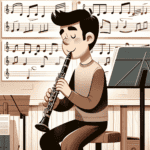Mastering the clarinet requires dedication to developing a strong and enduring embouchure. This fundamental aspect affects sound quality and playing stamina. A well-developed embouchure enables players to sustain notes, achieve better tone, and articulate cleanly, benefiting both beginners and advanced musicians.
Understanding Embouchure
Embouchure refers to how a player uses their facial muscles and shapes their mouth while playing a wind instrument. For clarinetists, an ideal embouchure includes:
- Lip Position: The lower lip slightly cushions the reed, with the upper lip covering the mouthpiece top, preventing unwanted vibrations and air leaks.
- Tongue Position: A relaxed tongue positioned for clean articulation. Pay attention to your tongue use during play.
- Facial Muscles: Engage the muscles around your mouth and cheeks to control the embouchure, which is key for endurance.
Building strong embouchure endurance requires consistent practice and significantly improves overall playing ability.
Exercises for Building Embouchure Endurance
Try these targeted exercises to enhance your embouchure strength and stamina:
| Exercise | Description | Benefits |
|---|---|---|
| Long Tones | Sustain a middle-register note, focusing on smooth, steady tone. Start with 10-15 seconds, gradually increase to 30+ seconds. | Improves tone stability and endurance |
| Lip Slurs | Play a series of lip slurs using various intervals, maintaining embouchure while transitioning between notes. | Enhances lip flexibility and overall endurance |
| Mouthpiece Exercises | Practice with just the mouthpiece and reed, holding long tones and focusing on stability and pressure. | Isolates and strengthens embouchure muscles |
| Dynamics Practice | Play long tones at varying dynamic levels, from piano to forte. | Improves control over mouthpiece and airflow |
| Alternating Notes | Select two notes a third or fifth apart and alternate smoothly between them. | Develops muscle memory and embouchure stability |
Strengthening Muscles Beyond the Lips
While lip focus is important, don't neglect other facial muscles. Cheek puffing exercises can boost endurance. Try blowing air through your lips while puffing your cheeks out, then drawing back in. This practice aids muscle control during play.
Using Quality Equipment
Your clarinet and accessories greatly influence your playing experience. High-quality instruments, such as Martin Freres clarinets, offer superior craftsmanship, enhancing resonance and sound projection. Investing in good equipment can significantly improve your practice sessions.
Maintaining Good Posture
Your posture while playing affects both air support and embouchure control:
- Maintain a straight posture, sitting or standing, with relaxed shoulders.
- Hold the clarinet at a comfortable angle.
- Keep your body relaxed while playing to maximize endurance.
Consistent practice of these exercises and techniques will improve your embouchure strength and overall playing experience. Remember, building and maintaining embouchure endurance is an ongoing process that requires regular practice.







